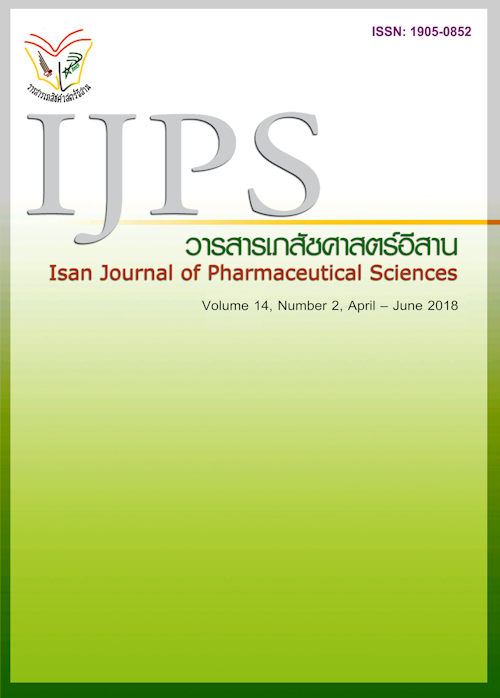Evaluation of Clinical Efficacy and Skin Irritation of a Topical Triphala Serum in Healthy Volunteers
Main Article Content
Abstract
Introduction: Triphala consists of the fruits of Terminalia chebula Retz., Terminalia bellirica Roxb., and Phyllanthus emblica Linn. The previous articles revealed that Triphala extract possessed antioxidant, inhibition of melanin synthesis, and anti-collagenase enzyme effects. The aim of this study was to develop topical Triphala serum and to investigate its effectiveness of the Triphala serum on skin parameters in healthy volunteers. Moreover, the skin irritation of the volunteers were also observed. Materials and methods: Triphala ethanolic extract was analyzed total phenolic content by using Folin-Ciocalteu assay and antioxidant activity by using DPPH assay. Triphala serum formulations were developed. Their physical and chemical stabilities were studied. Then, the serums in three concentrations of Triphala extract (0.5, 1.0, and 5.0%) were studied its effectiveness on skin parameters by using Multi-probe Adapter and Skin Visiometer® in healthy volunteers (n=31) after using the products for 30 days consecutively. In addition, the skin irritation was observed. Results: The Triphala extract had total phenolic content of 0.75 ± 0.02 mg GAE/mg extract. The concentration of Triphala that inhibited oxidation reaction of 50% (IC50) was 50.89 ± 0.60 µg/mL. In clinical study, both of 1.0 and 5.0% concentrations significantly reduced the melanin content comparing to serum base after using the Triphala serum for 30 days. However, Triphala serum showed no significant difference on skin wrinkles and skin smoothness after using for 30 days. In safety assessment, there was no report of skin irritation in all volunteers throughout this study. Conclusion: The developed topical Triphala serum at the concentration of 1.0 and 5.0% successfully decreased melanin content and showed no skin irritation after using for 30 days in clinical study.
Article Details
In the case that some parts are used by others The author must Confirm that obtaining permission to use some of the original authors. And must attach evidence That the permission has been included
References
Babu D, Gurumurthy P, Borra SK, et al. Antioxidant and free radical scavenging activity of triphala determined by using different in vitro models. J Med Plants Res 2013; 7(39): 2898-2905.
Boonmalee P, Tianwan P. Antioxidative and antityrosinase activities of Triphala cream. A special project submitted in partial fulfillment of the requirements for the degree of doctor of pharmacy. Faculty of Pharmacy, Mahidol University. 2013.
Kumar MS, Kirubanandan S, Sripriya R, et al. Triphala promotes healing of infected full-thickness dermal wound. J Surg Res 2008; 144(1): 94-101.
Kumar NS, Nair AS, Murali M, et al. Qualitative phytochemical analysis of triphala extracts. J Pharmacogn Phytochem 2017; 6(3): 248-251.
Naik GH, Priyadarsini KI, Bhagirathi RG, et al. In vitro antioxidant studies and free radical reactions of triphala, an ayurvedic formulation and its constituents. Phytother Res 2005; 19(7): 582-586.
Net-anong S, Kitipawong S, Ruangnoo S, Itharat A. Free radical scavenging activity and total phenolic content of different times for extraction triphala powder and its stability study. Thammasat Medical Journal 2015;15(3): 472-479.
Rasool M, Sabina EP. Antiinflammatory effect of the Indian Ayurvedic herbal formulation Triphala on adjuvant-induced arthritis in mice. Phytother Res 2007; 21(9): 889-894.
Sivasankar S, Lavanya R, Brindha P, et al. Aqueous and alcoholic extracts of Triphala and their active compounds chebulagic acid and chebulinic acid prevented epithelial to mesenchymal transition in retinal pigment epithelial cells, by inhibiting SMAD-3 phosphorylation. PLoS ONE 2015; 10(3): e0120512.
Sumantran VN, Kulkarni AA, Harsulkar A, et al. Hyaluronidase and collagenase inhibitory activities of the herbal formulation Triphala guggulu. J Biosci 2007; 32(4): 755-761.
Varma SR, Sivaprakasam TO, Mishra A, et al. Protective effects of triphala on dermal fibroblasts and human keratinocytes. PLoS ONE 2016; 11(1): e0145921.


